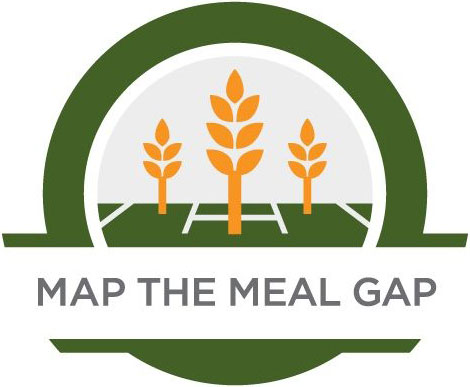MAP THE MEAL GAP
Feeding America’s® latest Map the Meal Gap report was released in May 2025 with 2023 food insecurity data. The study provides local-level estimates of food insecurity and food costs for every county and congressional district in the United States. Map the Meal Gap builds upon the USDA’s latest report of national and state information, which shows an increase in food insecurity with higher food costs and increases in other basic needs.
Food insecurity levels vary across regions, influenced by factors such as unemployment, poverty rates as well as policies and practices rooted in history that often have led to generational poverty and hold people back today.
*Food insecurity is defined by the USDA as lack of access, at times, to enough food for an active, healthy life for all household members.
What the Map Says about New Mexico
Map the Meal Gap 2025 confirms that food insecurity affects and exists in every county in Roadrunner Food Bank’s service area. The Map the Meal Gap study is a powerful tool to help us understand the local impact of hunger and act. We can leverage this information to address factors that impact food insecurity in New Mexico and bring people together to ensure everyone has access to the food, nutrition and resources we all need to thrive.
The report shows that New Mexico’s hunger rates are higher than the national averages. In the state, 16.6% (1 in 6) are food insecure compared to 14.3% nationally. New Mexico has the seventh highest hunger rates among all states for the overall population.
Twenty-three percent of kids (1 in 4) in the state are at risk of hunger compared to 19.2 percent nationally.
In addition, the report shows that the cost per meal is $3.32 and the meal gap for New Mexico is 66,402,403 meals. The meal gap grew more than six million meals from the last report released in the spring 2024. The reported annual food budget shortfall for people at risk of experiencing food insecurity is more than $220,456,000 in New Mexico.
Children and Hunger
Map the Meal Gap 2025 revealed that New Mexico children face hunger at much higher rates than the overall population. As a state, New Mexico ranks fourth highest for childhood food insecurity behind Arkansas (24%), Oklahoma (24%), and Louisiana (23.4%). The data released shows one in four children is at risk of hunger in New Mexico, or 23.3% of all children in the state.
Rankings by County
New Mexico Counties with the Highest Percentages of Child Hunger
- Catron County – 37.6%
- McKinley County – 33.8%
- Luna County – 31.8%
- Cibola County – 31.1% (tie)
- Sierra County – 31.1% (tie)
New Mexico Counties with the Highest Percentages for Overall Hunger
- McKinley County – 22.9%
- Luna County – 22.8%
- Sierra County – 21.9%
- Socorro County – 21.6%
- Catron County – 21.3%
It is important to note that the New Mexico counties listed above are all in primarily rural or frontier communities often defined as “food deserts” – geographical areas that have limited access to affordable, healthy and nutritious food options.
Seniors and Older New Mexicans
The study also revealed that the state is ranked 3rd for Older New Mexicans with 46,163 or 18.4% at risk of experiencing food insecurity or 1 in 5. Mississippi and Indiana had the highest Older American food insecurity rate of 19.6%. It also revealed that 59,360 or 10.7% of Seniors or 1 in 9 are at risk of hunger in New Mexico.
Hispanics, Latinos, and Black Americans
The study for the fourth year includes food insecurity rates for several racial and ethnic groups at the local level and reveals that disparities can vary greatly by population and place.
According to the report, the state is made up of 48% Hispanic or Latino. Food insecurity rates among Hispanics in the state are 21% or 1 in 5. In addition, Black New Mexicans make up 2% of the state’s population. Of Black New Mexicans, 30% or 1 in 3 are in food insecure households.
Interactive Map and Data Visualization
For more information about Map the Meal Gap, visit this interactive map. Additional research and resources can be found via Tableau Public.
Further Reading About the Study
You can read additional information about Map the Meal Gap on Feeding America’s website for more insight into what the data means. View a map by county or state here. You can also request data tables or congressional district data here.
To explore the various research tools and briefs available from Feeding America, visit feedingamerica.org/research.

